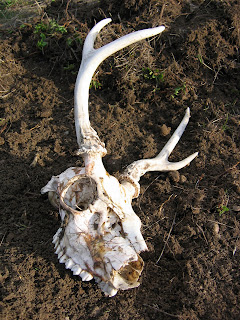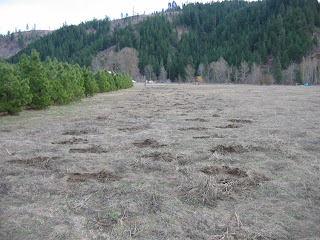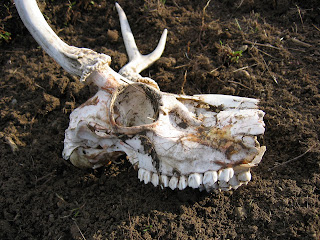200 Scalps, 1 Dead Deer
Our entire property is under a "Forest Stewardship Plan". Our management plan has a 10 year outlook and delineates the things we plan to do during that 10 years to maintain and improve our forest land. We agree that the ultimate goal of managing our forest is commercial timber harvest; in return, the county taxes our property at the lowest available tax rate, with the idea being that they'll make their money back with excise taxes on the timber when it is sold.
When we purchased the property last January, we were required to submit a management plan to the county. So we took the plan that the Clausens had last written, did some routine updating (average tree diameters and ages, etc.), and submitted this plan. (Read the full story in this post.) And the county promptly rejected it.
Huh? This was a plan that was perfectly acceptable when the Clausens submitted it, and nothing significant in the plan had changed. So what was different? Their objection: not enough of our property was forested.
From Washington RCW 84.33.035:
"Forest land" is synonymous with "designated forest land" and means any parcel of land that is twenty or more acres or multiple parcels of land that are contiguous and total twenty or more acres that is or are devoted primarily to growing and harvesting timber. Designated forest land means the land only and does not include a residential homesite. The term includes land used for incidental uses that are compatible with the growing and harvesting of timber but no more than ten percent of the land may be used for such incidental uses. It also includes the land on which appurtenances necessary for the production, preparation, or sale of the timber products exist in conjunction with land producing these products.
This law hasn't changed recently, so it appears that the only difference between our submission and the Clausens is enforcement of that law. Anyway, the long story short is that we have three years to plant our southern meadow in trees or decide to take that portion of the property out of our management plan (and pay the associated back taxes on it.)
This year we decided to do an experiment in forestry. The biggest cost is not in the trees, it's definitely in the labor. For this first year, we decided that we would do all of the preparation and planting ourselves. So we ordered a small number of Ponderosa Pine seedlings - 200, to be exact - from our friends at the Underwood Conservation District, at a total cost of $80. We borrowed a few of their tools and headed out into our meadow to do some site preparation. Grasses are one of the biggest enemies of young trees; grasses can drink all of the water that falls on an area before that water can get to the tree roots. So the key pre-planting step is to "scalp" the grass off of the ground around the area where you plan to plant a seedling. Then repeat 199 more times.
The weather was great for working outside, so we took our time. We opted for a "pseudo-random" planting of about 8-12 feet spacing, rather than more of the exacting rows in which our current trees are planted. In all, it took us about 5 hours over 2 days to scalp the grass from 200 circles, including the time we spent relaxing on the ground. Estimating that each scalped section is a 2.5' square, we scalped over 1200 sq ft of ground. We plan to pick up and plant the trees next weekend.
We'll now leave you with some shots of the remains of a deer. We first encountered this skeleton last November when it was considerably more "fresh" (i.e. not yet entirely a skeleton), but he has since been picked clean. Many of the other bones - leg, vertebrae - are still in the field as well.

- Mike (& Corinne)






No comments:
Post a Comment